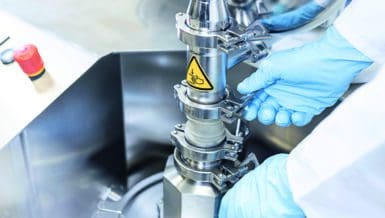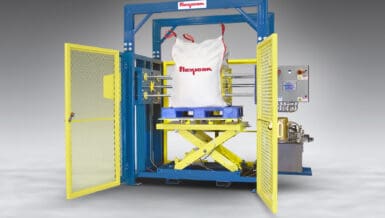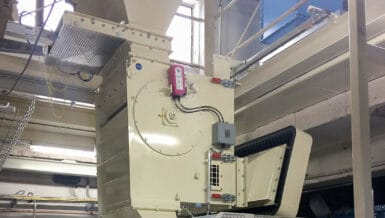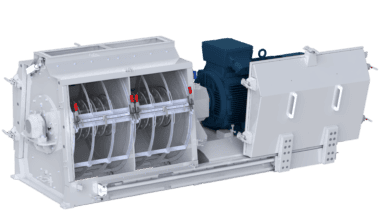This unique design is ideal for two distinct processing goals: reducing large, bulky materials to a fine consistency, and grinding free-flowing material to an ultra-fine finished particle size.
While traditional hammer mills work on the principle that most materials will crush, shatter or pulverize upon impact. That material is fed into the mill’s chamber through the feed chute and struck by ganged hammers, which are attached to a shaft that rotates at high speed inside the mill’s grinding chamber. The material is crushed or shattered by a combination of repeated hammer impacts, collisions with the walls of the grinding chamber, and particle on particle impact. The initial impact of the slow-moving particles against the high tip speed of the hammers produces the most significant size reduction. As the particles begin to reach the tip speed of the hammers, less reduction occurs because the energy transfer drops as the velocity differential levels out. Perforated metal screens or bar grates covering the discharge opening of the mill retain coarse material for further grinding until the particle size and approach angles are aligned, allowing properly sized materials to pass as a finished product.
By contrast, dual-stage hammer mills, like the Schutte Hammermill RA dual-stage hammer mill, are designed specifically to maximize space and efficiency by producing the finest possible end-product in just one pass. Dual-stage mills feature two independently driven hammer mills stacked one over the other.
In a dual-stage hammer mill, there are really three phases of size reduction, due to what is known as the attrition zone. The attrition zone is the area created between the top rotor and bottom rotor of a dual-stage hammer mill. Materials pass through the initial mill and screen arrangement and are then directed toward the secondary mill chamber. Before reaching the second rotor, particle-to-particle impact in the attrition zone creates additional opportunities for size reduction. The turbulence created by the opposing rotors, and a continuous stream of particles creates high impact forces; serving two purposes:
- The reduction of large bulky materials to a fine and uniform consistency, with just one pass
- The reduction of friable materials that are free-flowing to an ultrafine particle size with one pass
Energy transferred from particle-to-particle impact at very high speeds produces the increased gradation at a finer particle range. More size reduction occurs as significant energy is exchanged from the repeated collisions between particles and hammers until the material finally passes through the secondary screen at the desired particle size. The RA series hammer mill is available in five standard sizes, with custom models available on request, comes with the option of carbon or stainless construction, and multiple hammer styles and sizes.









































